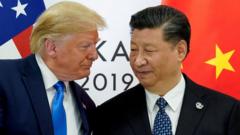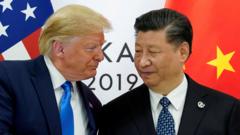Since early April, China has ceased nearly all shipments of rare earth metals critical for various technologies, raising alarms among global industries about potential production halts.
China Halts Rare Earth Exports: Implications for Global Industries

China Halts Rare Earth Exports: Implications for Global Industries
China's suspension of rare earth metal exports is causing significant disruptions in the manufacturing sectors of the U.S. and Europe.
China has imposed a near-total ban on the export of seven key rare earth metals as of April 4, 2025. This move has led to acute supply shortages, posing risks to countless factories in the United States and Europe that rely on these materials. With demand rising for electric vehicles, renewable energy technologies, and defense applications, the impact of these shortages could be monumental.
Rare earth metals are a collection of 17 elements situated near the bottom of the periodic table, and while not tremendously rare in terms of global presence, they are challenging to extract and process. The labor-intensive extraction process means that these metals often require extensive chemical treatment, which usually involves over 100 steps using strong acids.
China dominates the rare earth market, producing around 70% of the world’s supply. However, its processing capabilities are even more pronounced, as it handles about 90% of the raw refinement required globally. Other sources such as Myanmar, Australia, and the United States contribute to the extraction of these minerals, but they largely depend on Chinese facilities for processing.
Experts warn that if the trade embargo continues, it could severely disrupt supply chains across various industries, forcing companies to seek alternative sources while grappling with escalating costs and logistical hurdles. As countries strive for technological advancements, the strategic mining and processing of rare earths will likely become a focal point of international policy discussions in the years ahead.
Rare earth metals are a collection of 17 elements situated near the bottom of the periodic table, and while not tremendously rare in terms of global presence, they are challenging to extract and process. The labor-intensive extraction process means that these metals often require extensive chemical treatment, which usually involves over 100 steps using strong acids.
China dominates the rare earth market, producing around 70% of the world’s supply. However, its processing capabilities are even more pronounced, as it handles about 90% of the raw refinement required globally. Other sources such as Myanmar, Australia, and the United States contribute to the extraction of these minerals, but they largely depend on Chinese facilities for processing.
Experts warn that if the trade embargo continues, it could severely disrupt supply chains across various industries, forcing companies to seek alternative sources while grappling with escalating costs and logistical hurdles. As countries strive for technological advancements, the strategic mining and processing of rare earths will likely become a focal point of international policy discussions in the years ahead.






















